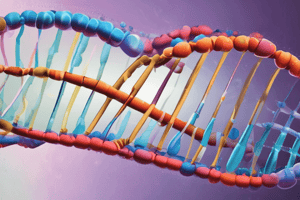Podcast
Questions and Answers
What is the process of copying double-stranded DNA to produce an identical double-stranded DNA called?
What is the process of copying double-stranded DNA to produce an identical double-stranded DNA called?
- Transcription
- RNA Replication
- Protein Synthesis
- DNA Replication (correct)
What enzyme separates the DNA strand into two separate strands?
What enzyme separates the DNA strand into two separate strands?
Helicase
What are the single strand binding proteins that prevent reannealing of single-stranded DNA?
What are the single strand binding proteins that prevent reannealing of single-stranded DNA?
SSB Protein
Which enzyme creates RNA primers needed to start the replication process?
Which enzyme creates RNA primers needed to start the replication process?
Which component helps hold polymerase on the DNA strand during replication?
Which component helps hold polymerase on the DNA strand during replication?
What removes RNA primers that previously began the synthesis?
What removes RNA primers that previously began the synthesis?
What enzyme links short DNA chains to create one long continuous DNA strand?
What enzyme links short DNA chains to create one long continuous DNA strand?
What are the DNA pieces that are separated due to the lagging strand called?
What are the DNA pieces that are separated due to the lagging strand called?
What model represents the mechanism by which DNA is replicated in cells, consisting of half parental DNA and half new DNA?
What model represents the mechanism by which DNA is replicated in cells, consisting of half parental DNA and half new DNA?
What is the continuously synthesized strand during DNA replication called?
What is the continuously synthesized strand during DNA replication called?
What is the discontinuously synthesized strand during DNA replication called?
What is the discontinuously synthesized strand during DNA replication called?
In what direction do DNA strands replicate?
In what direction do DNA strands replicate?
Flashcards are hidden until you start studying
Study Notes
DNA Replication Overview
- DNA replication involves duplicating a double-stranded DNA molecule to produce two identical strands, essential for heredity.
Key Enzymes and Proteins
- Helicase: An enzyme that unwinds and separates DNA strands, forming two single strands during replication.
- SSB Protein: Coats single-stranded DNA to prevent reannealing, ensuring the strands remain separated for replication; consists of 178 amino acids.
- Primase: Creates RNA primers necessary to initiate the synthesis process; classified as a type of RNA polymerase.
- Sliding Clamp: Assists in holding DNA polymerase onto the DNA strand, enhancing the process of replication.
- RNase H: Responsible for removing RNA primers used during the initial steps of DNA synthesis.
- DNA Ligase: Joins short DNA fragments into a continuous DNA strand, mainly functioning on the backbone of the DNA.
Structure and Function of DNA Strands
- Okazaki Fragments: Short DNA segments formed on the lagging strand due to the discontinuous nature of its synthesis; identified by scientist Reiji Okazaki.
- Semi-conservative Model: Each daughter DNA strand contains one original (parental) and one new strand, promoting genetic continuity.
Leading and Lagging Strands
- Leading Strand: Synthesized continuously, allows for straightforward addition of nucleotides during replication.
- Lagging Strand: Synthesized discontinuously, leading to the creation of fragments that must be later joined together.
Directionality of DNA Synthesis
- DNA replication occurs from the 5' to 3' direction; DNA polymerase attaches nucleotides in this specific orientation. Okazaki fragments form as a result of DNA polymerase working in the 3' to 5' direction.
Studying That Suits You
Use AI to generate personalized quizzes and flashcards to suit your learning preferences.




